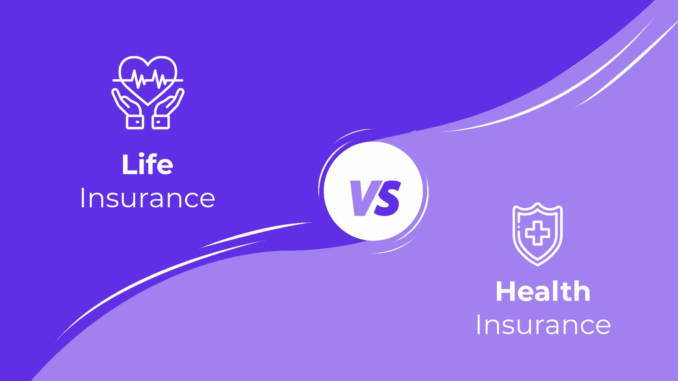
Life Insurance vs Health Insurance: What’s the Difference?
When it comes to financial planning, two of the most crucial yet often misunderstood tools are life insurance and health insurance. While both provide essential protection, they serve very different purposes. Understanding the distinction between life and health insurance can help you make smarter decisions, ensure you’re adequately covered, and avoid costly mistakes.
In this article, we’ll explore what each type of insurance covers, how they work, and the key differences between them in 2025.
What Is Life Insurance?
Life insurance is a financial contract between you and an insurance provider. You pay regular premiums, and in return, the insurer agrees to pay a lump sum (called a death benefit) to your beneficiaries in the event of your death. The main goal of life insurance is to provide financial support to your loved ones when you’re no longer around.
Types of Life Insurance:
- Term Life Insurance
- Provides coverage for a specific period (e.g., 10, 20, or 30 years).
- Generally more affordable.
- No payout if you outlive the term.
- Whole Life Insurance
- Covers you for your entire life.
- Includes a savings or investment component called “cash value.”
- Premiums are higher but fixed.
- Universal Life Insurance
- Flexible premiums and death benefits.
- Builds cash value based on market interest rates.
What Is Health Insurance?
Health insurance helps cover the cost of medical care. Whether it’s a routine doctor’s visit or an unexpected surgery, health insurance can dramatically reduce your out-of-pocket expenses. This is especially important as healthcare costs continue to rise in 2025.
Types of Health Insurance:
- Individual Health Insurance
- Purchased directly from insurance providers or government marketplaces.
- Tailored to individuals or families not covered by an employer.
- Employer-Sponsored Health Insurance
- Offered as a benefit by many companies.
- Often subsidized to reduce employee costs.
- Government Health Insurance
- Includes Medicare, Medicaid, or country-specific national healthcare programs.
- Private Health Insurance
- Offers more options and faster service than many public plans.
- Often used to supplement government-provided care.
Key Differences Between Life Insurance and Health Insurance
| Feature | Life Insurance | Health Insurance |
|---|---|---|
| Purpose | Provides financial support to beneficiaries after death | Covers medical expenses while you’re alive |
| Beneficiaries | Family members or designated individuals | You (the policyholder) benefit directly |
| Payout Type | Lump-sum death benefit | Ongoing medical bill coverage |
| Claim Trigger | Death of the insured person | Medical treatments, hospitalizations, preventive care |
| Premium Cost | Depends on age, health, and coverage amount | Based on age, medical history, coverage plan, and location |
| Policy Term | Fixed term or lifetime | Annual or short-term (usually renewed yearly) |
Why You Might Need Life Insurance
Life insurance is essential if you:
- Have dependents (spouse, children, elderly parents).
- Carry debt (like a mortgage) that could burden your family.
- Want to leave a legacy or donate to a cause.
- Own a business and want to ensure continuity after your passing.
Example:
John, a 35-year-old father of two, buys a 20-year term life policy worth $500,000. If he passes away during that term, his family receives the payout, which can cover living expenses, education costs, and the mortgage.
Why You Might Need Health Insurance
Health insurance is essential if you:
- Want to reduce medical costs, especially in emergencies.
- Require regular prescriptions or chronic disease management.
- Plan to have children and need maternity care.
- Need preventive care like checkups and vaccines.
Example:
Sarah, a 28-year-old freelancer, chooses a private health insurance plan that covers doctor visits, lab tests, and hospitalization. When she develops a kidney infection, her policy covers 90% of her $5,000 treatment cost.
Can You Have Both Life and Health Insurance?
Absolutely—and in most cases, you should. These two types of insurance serve complementary purposes. While health insurance helps you manage medical costs and stay healthy, life insurance ensures your loved ones are protected financially in the long term.
In 2025, many insurers offer bundled packages or financial wellness plans that combine both types, offering convenience and discounts.
How to Choose the Right Life Insurance Plan
When selecting life insurance, consider:
- Coverage amount: Calculate how much your family would need to maintain their lifestyle.
- Policy term: Match it with financial goals (e.g., until your children graduate).
- Premium affordability: Choose a plan that fits your long-term budget.
- Insurer reputation: Check claim settlement ratios and customer reviews.
How to Choose the Right Health Insurance Plan
When selecting health insurance, consider:
- Network hospitals and doctors: Ensure your preferred providers are covered.
- Coverage limits: Understand what’s included and what’s not.
- Deductibles and co-pays: Lower premiums may come with higher out-of-pocket costs.
- Prescription coverage: If you take medication regularly, ensure it’s included.
What’s New in 2025: Life and Health Insurance Trends
- Digital Platforms: Policy buying, management, and claim filing are now mostly online or app-based.
- AI-Powered Underwriting: Faster and more personalized quotes based on smart data analysis.
- Telemedicine Coverage: Most health plans now cover online doctor consultations.
- Eco-conscious Plans: Some life insurance providers offer discounts for low-risk, eco-friendly lifestyles.
- Integrated Wellness Programs: Health insurers reward policyholders for staying active and maintaining healthy habits.
Common Myths Debunked
- Myth: “I’m young and healthy, I don’t need insurance.”
Reality: Young age often means lower premiums and better long-term value. - Myth: “Employer insurance is enough.”
Reality: Employer plans may not offer sufficient coverage, and they end when you leave the job. - Myth: “Life insurance is too expensive.”
Reality: Term life insurance can cost less than a daily cup of coffee.
Final Thoughts
Both life and health insurance are essential components of a solid financial plan. While health insurance protects you from the rising costs of medical care, life insurance secures your family’s financial future. Rather than viewing them as either/or options, think of them as two sides of the same coin.
Before you buy, take the time to assess your needs, research providers, and compare policies. Making an informed choice today can protect you and your loved ones for years to come.

